How to choose a pump for pumping dirty water: selection rules and an overview of the best models
Happy owners of suburban areas know from their own experience that to solve the problem of pumping dirty water is quite problematic without the use of a garden pump. This device, necessary for the household, will help in two ways to empty the decorative pond in the garden, and, if necessary, to pump out the basement flooded by flood waters.
What types of equipment the modern market offers and how to choose a pump for dirty water, we will consider in the article.
The content of the article:
Design features of devices
The main purpose of pumps designed for pumping is to drain the storage tanks and to remove accumulated moisture during floods. And in case of emergencies and empty the flooded basements and cellars.
Modern models of pumps for pumping dirty water can be used to solve many problems:
- clean the well shaft from silt and sand deposits;
- remove "blooming" water from an open reservoir in the garden;
- apply when arranging a drainage system.
Unlike downhole devices, such pumps are capable of passing fibers, solids and small stones. Thanks to this, they are indispensable universal assistants in performing business tasks.
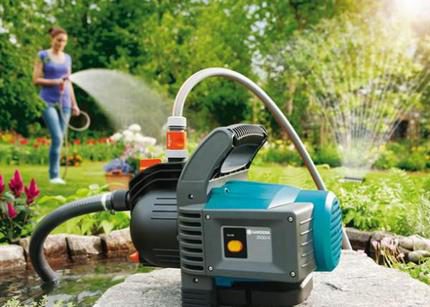
The design of any dirty water garden pump is similar. The device consists of a metal or plastic case, inside of which is placed an electric motor and a pump unit.
When you turn on the electric motor, a vacuum is created inside the housing. Under the action of low pressure, the liquid is sucked into the chamber, passing through which it moves to the outlet hose and is pushed out with force.
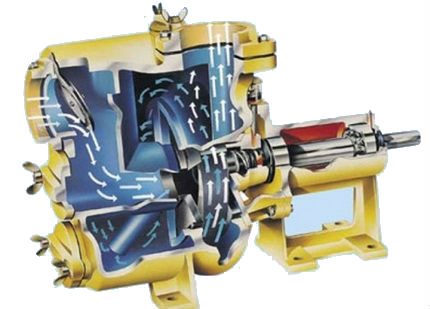
Depending on the method of creating a vacuum inside the chamber of the device, the pumps are divided into three groups:
- Centrifugal - work due to the fact that under the action of rotation of the wheel blades and the working part, the fluid is drawn into the housing. Under the pressure of centrifugal force, it is pressed against the wall and then pushed into the outlet.
- Vibrating - based on the effects of the electromagnetic field created by the coil. A metal core equipped with a flexible diaphragm, being pulled into the coil, creates a low pressure, under the influence of which liquid is sucked into the hydraulic chamber. When the curved diaphragm returns to its original position, the pressure inside the chamber rises, and the water is pushed into the outlet pipe.
- Whirlwind - work due to the rotation of a metal disk with blades, referred to as a vortex wheel. Under its action, water is twisted into a vortex spiral, creating a powerful pressure at the outlet.
For pumping contaminated liquids at the household level, site owners mainly choose vibration and centrifugal devices.
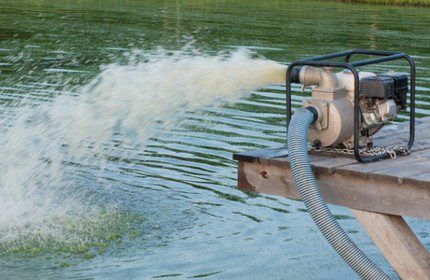
Vortex-type models in pumping water with contaminants and inclusions are extremely rare, since they are very sensitive to suspended particles in water. We also recommend that you familiarize yourself with our other material, in which we described in detail principle of operation drainage pumps and posted tips on their choice.
Varieties of dirty water pumps
Depending on the method of water intake and the location of the unit casing relative to the tank, dirty garden water pumps are divided into two types: surface and submersible.
Surface Models
This range of units is a system that does not immerse in water. They are placed near a pond, and water is taken by immersion of a strain-resistant suction hose or pipe.
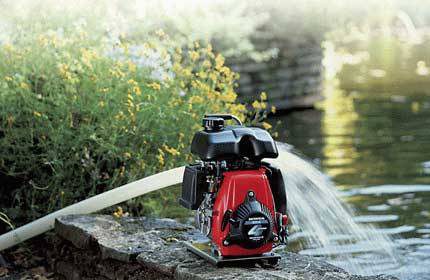
The surface pump housing can be made of plastic or metal. Units with a plastic case work quietly, and are inexpensive. But plastic is a rather fragile material that can withstand only minor mechanical stresses.
Pumps with a metal casing, although quite loudly buzz during the pumping process, are not so afraid of shock. And because they are famous for a longer service life. In order to slightly reduce the level of “growling” that occurs during vibration during pumping water, the craftsmen recommend placing the device’s body on a special platform equipped with a rubberized rug.
When mounting the unit in tightly closed pits, it is recommended that the bottom of the substrate be covered with gravel or gravel. Bulk materials will simultaneously perform two functions: reduce the vibration of the body and absorb excess moisture.
Among the main advantages of surface aggregates, it is worth highlighting:
- Simplicity of operation. Due to their compact dimensions and low weight, they are conveniently moved around the territory, installing in the right place. In case of bad weather, it can always be cleaned indoors.
- Universality of application. To start the device, it is enough to install it on a flat platform, place the end of the suction hose in a filled tank, at the final stage - connect to the mains.
- Affordable price. The wide price range of surface-mounted pumps available for sale allows you to choose a model that will satisfy the wishes and material capabilities of any consumer.
The only “minus” of surface aggregates is the limited depth. Most models can work without overloads only at a depth of five to seven meters.
But it is worth considering that the farther the unit is removed from the water intake, the lower its suction capacity. For this reason, the installation location of the device should be located as close as possible to the water intake.
Single-phase low-power devices are more suitable for irregular use. With frequent use, there is a high probability of their rapid incapacitation. Since in winter when pumping water using surface pumps there is a high risk of freezing of the system, it is better to transfer them to closed rooms or wrap them at this time of the year.
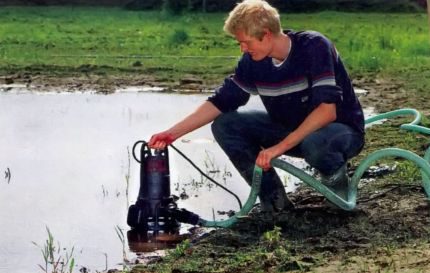
Submersible devices
Submersible models differ in that the water intake in these devices is carried out directly through the pump without hoses. Units are completely immersed in water and lowered to the bottom of the intake.
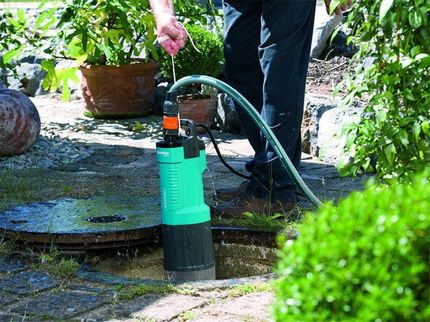
Submersible models are relatively quiet operation. During the operation of the device, you only need to monitor the water level so that it does not fall below the critical level, while the pump does not suck in air, that is, it does not work “dry”. To avoid this, preference should be given to models equipped with float switch.
When working at great depths, the installation in the ejector body helps to ensure the stability of the suction. Due to this, the device will function normally even if there are air jams in the system.
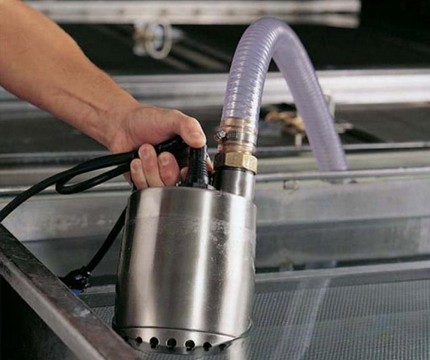
Submersible pumps are famous for their good resistance to temperature extremes and aggressive agents, which is especially valuable when used to equip drainage systems. Indeed, dirty water can be saturated with various kinds of chemical compounds, as well as numerous alkaline and salt impurities.
Powerful three-phase devices are capable of pumping contaminated water, the diameter of solid particles in which reaches 50 mm. Such units are equipped with strainers with wide chambers. Through them, contaminated water, along with garbage and fibers, is freely pumped without clogging the system.
Competent selection criteria
Choosing a suitable model for domestic needs, you should focus primarily on what functions it is intended to perform, what characteristics it has.
Scope of the unit
Planning to use the unit only for watering garden beds from a nearby reservoir or to drain a flooded cellar, you can do with a device with a capacity of 120 l / min.
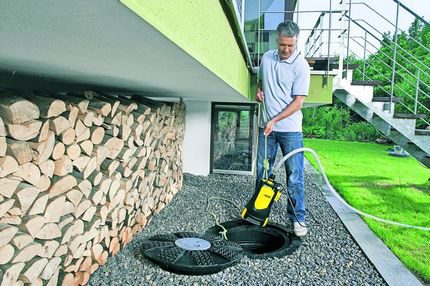
The size of the solid elements that the unit is able to “digest” is indicated in the instructions for the specific model. On sale you can find models designed only for slightly polluted water, in the structure of which only a small amount of sand can be present. Units that successfully cope even with small stones are also presented in a wide assortment.
When planning to use the unit for pumping dirty water, including fibrous structures and bulky garbage, it is worth considering the option of acquisition fecal pump.
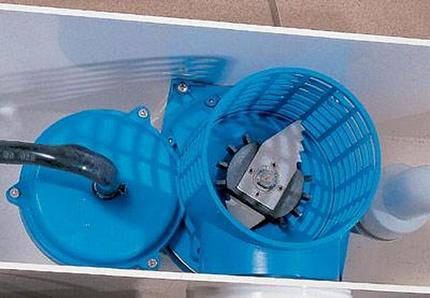
In addition, aggregates of this type are created from materials with increased strength, and are not afraid of the effects of an aggressive environment. Therefore, they have a longer service life than conventional dirty water garden pumps.
Performance and pressure
When purchasing a dirty water pump, pay special attention to its technical characteristics:
- Performance - the amount of pumped fluid per minute.
- Pressure - the ability to push water to a certain height.
When calculating the required power of the device, it should be borne in mind that the ratio of vertical and horizontal lengths will be 1: 4. This means that one meter of vertical pipeline will correspond to four meters of horizontal.

If you are in doubt when performing calculations to select a device, consult a specialist in addition.
Suction valve location
Suction openings can be located in the bottom of the device or its upper part above the engine compartment. Devices whose suction valves are located in the bottom of the housing demonstrate much greater efficiency. They are capable of pumping water out of the tank with virtually no residue.
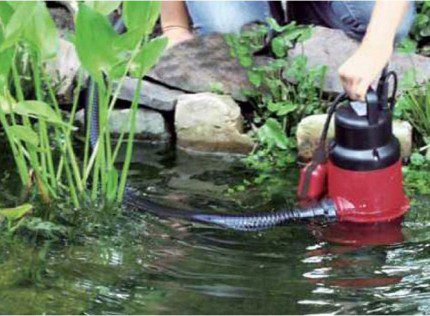
For drainage of reservoirs and filled tanks, it is worth choosing units whose suction valves are located on the upper case. The "upper" pumps are more durable due to the fact that the placement of the suction pipe above the engine compartment minimizes the risk of damage to the working chamber when large particles get into it.
When working with pumps, the suction openings of which are located at the bottom of the device, experienced owners recommend placing the units on special stands.
Auto shut off float
Although automation increases the cost of equipment, it helps prevent overheating of the motor.
The float is a device in the form of a plastic floating box. Inside it is placed an electric cable and a steel ball. It reacts to a change in water level and closes / opens the contacts of the switch.
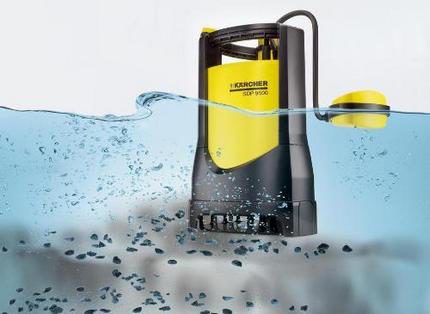
The main advantage of the device is that it simultaneously performs two functions: it acts as a water level sensor and serves as an actuator for controlling the pump.
Having spent a little more money on a device equipped with an automation system, you can not worry that after pumping water it will work “dry”. The only thing is that once every few months it is recommended that the float switch be flushed with a stream of water under pressure from pollution. Preventive cleaning will prevent sticking of the float to the outlet pipe.
Comparative review of the best manufacturers
The market leader is rightfully considered the company "Grundfos ». The Danish company is the oldest manufacturer of pumping equipment. The developments introduced by the technologists of the leading company were subsequently adopted by other manufacturers.
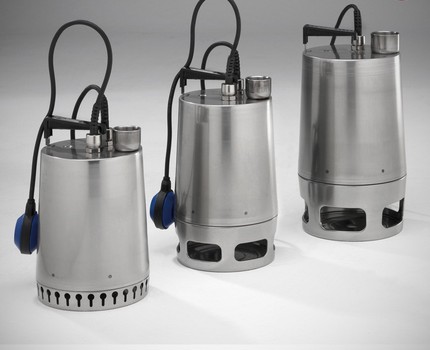
The product range is presented by pumps of all varieties and types. And all of them are united by one thing - the highest quality, confirmed by the manufacturer's effective guarantee.
Another import brand that has earned a positive reputation with customers from around the world is the brand "Pedpollo".
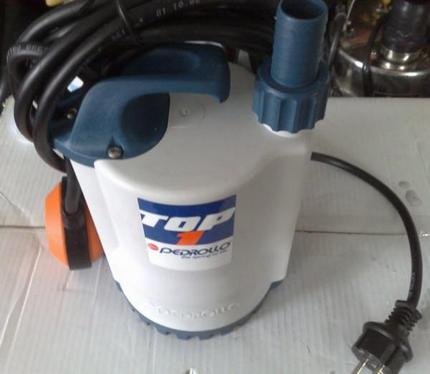
“Pedrollo pumps work everywhere” is the main slogan of the world famous brand. And if you study the characteristics of the equipment manufactured by him, then it is worth highlighting the versatility of its application. Pumps are able to work in polluted water, in an aggressive environment and at high temperatures.
Among domestic-made pumping equipment, products manufactured under such trademarks have proven themselves best:
- Gilex - pumping equipment of a domestic manufacturer is focused on the conditions of the Russian hinterland with its abundance of “complex” soils and wetlands, as well as possible power grid fluctuations.
- "Vortex" - pumps of this manufacturer are famous for their high power and low noise. Certified equipment manufactured by the company passes numerous tests for performance and endurance.
- "Foreman" - powerful and unpretentious in maintenance pumps of this brand are manufactured on the basis of advanced technologies. This allows the company to keep the bar for quality at a high level.
Among the brands of dirty water pumps, brands have also worked well. "DAB", "Karcher" and Belamos. The equipment manufactured under these brands is famous for the optimal ratio of price and quality.
By acquiring the right model, you have to prioritize: pay more and choose an undeniable European brand or purchase an inexpensive product of domestic production, but at the risk of getting low-quality warranty support.
In order not to doubt your choice, we suggest that you familiarize yourself with rated drainage pumps.
Conclusions and useful video on the topic
What are the differences from a dirty water pump from drainage equipment:
If there is no electricity on your site, the only solution to the problem is to purchase a manual pump pump. The pumping of fluid through such units is carried out by the movement of the piston, which increases the pressure in one chamber and lowers in another.
The price of products ranges from 150 cu But, as with the selection of similar electrical models, key attention should be paid to what size of solid inclusions they are designed for.
Looking for a pump to pump dirty water? Or do you already have experience using such equipment and can you give practical advice to our readers? Please write comments in the block below.

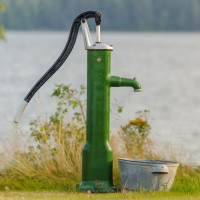 DIY manual water pump: a review of the best homemade products
DIY manual water pump: a review of the best homemade products 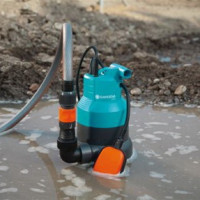 How to choose a drainage pump: review of options + rating of the best equipment on the market
How to choose a drainage pump: review of options + rating of the best equipment on the market 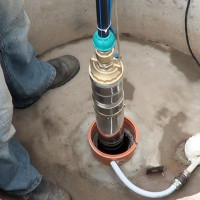 Submersible pumps for the well: 15 best models + tips for customers
Submersible pumps for the well: 15 best models + tips for customers 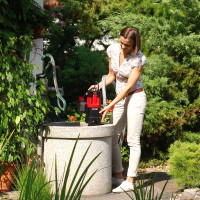 Choosing a pump for a well: how to choose a unit + an overview of the best brands
Choosing a pump for a well: how to choose a unit + an overview of the best brands 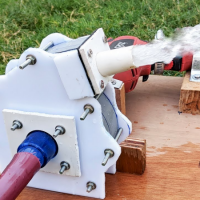 How to make a water pump with your own hands: we disassemble the 13 best homemade options
How to make a water pump with your own hands: we disassemble the 13 best homemade options 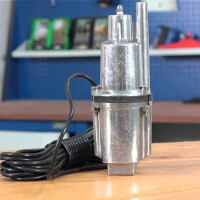 Overview of the Rodnichok water pump: device, characteristics, operating rules
Overview of the Rodnichok water pump: device, characteristics, operating rules  How much does it cost to connect gas to a private house: the price of organizing gas supply
How much does it cost to connect gas to a private house: the price of organizing gas supply  The best washing machines with dryer: model rating and customer tips
The best washing machines with dryer: model rating and customer tips  What is the color temperature of light and the nuances of choosing the temperature of the lamps to suit your needs
What is the color temperature of light and the nuances of choosing the temperature of the lamps to suit your needs  Replacement of a geyser in an apartment: replacement paperwork + basic norms and requirements
Replacement of a geyser in an apartment: replacement paperwork + basic norms and requirements
This spring, the basement in the country was flooded several times with flood waters. Especially for their pumping bought an inexpensive surface pump. The unit burned out during the third use. Warranty repairs were refused, because we violated the operating conditions, since the pump was idling for some time. Now we have purchased a pump with an integrated grinder for taking water from the pond at the end of the site. Hope it lasts a long time.
For 10 years now, a submersible pump type Malysh has been working regularly in our country. The design is very simple, one might even say primitive, but he never failed. I won’t say exactly the depth of the well, about thirty meters, I think. Pressure gives good. We use water for irrigation. In the spring, you yourself understand what dirt is accumulating, but it perfectly pulls everything out. Here you have the simplest pump.